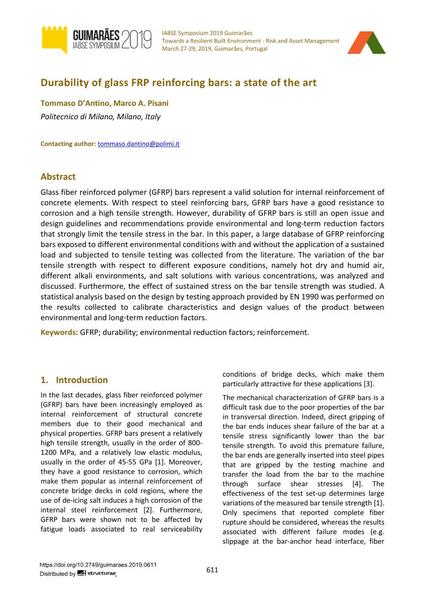Durability of glass FRP reinforcing bars: a state of the art

|
|
|||||||||||
Bibliographic Details
| Author(s): |
Tommaso D'Antino
(Politecnico di Milano, Milano, Italy)
Marco A. Pisani (Politecnico di Milano, Milano, Italy) |
||||
|---|---|---|---|---|---|
| Medium: | conference paper | ||||
| Language(s): | English | ||||
| Conference: | IABSE Symposium: Towards a Resilient Built Environment Risk and Asset Management, Guimarães, Portugal, 27-29 March 2019 | ||||
| Published in: | IABSE Symposium Guimarães 2019 | ||||
|
|||||
| Page(s): | 611-618 | ||||
| Total no. of pages: | 8 | ||||
| DOI: | 10.2749/guimaraes.2019.0611 | ||||
| Abstract: |
Glass fiber reinforced polymer (GFRP) bars represent a valid solution for internal reinforcement of concrete elements. With respect to steel reinforcing bars, GFRP bars have a good resistance to corrosion and a high tensile strength. However, durability of GFRP bars is still an open issue and design guidelines and recommendations provide environmental and long-term reduction factors that strongly limit the tensile stress in the bar. In this paper, a large database of GFRP reinforcing bars exposed to different environmental conditions with and without the application of a sustained load and subjected to tensile testing was collected from the literature. The variation of the bar tensile strength with respect to different exposure conditions, namely hot dry and humid air, different alkali environments, and salt solutions with various concentrations, was analyzed and discussed. Furthermore, the effect of sustained stress on the bar tensile strength was studied. A statistical analysis based on the design by testing approach provided by EN 1990 was performed on the results collected to calibrate characteristics and design values of the product between environmental and long-term reduction factors. |
||||
| Keywords: |
durability reinforcement Reinforcing GFRP environmental reduction factors
|
||||
